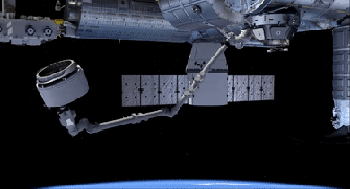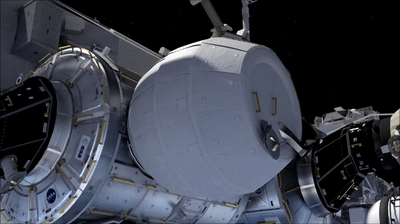Don't wanna be here? Send us removal request.
Photo

If Earth Had Rings Like Saturn
via reddit
2K notes
·
View notes
Photo

The Planets, If They Were As Far Away From Earth As The Moon
via reddit
13K notes
·
View notes
Photo









Here’s the orbital period of our solar system’s 8 major planets (how long it takes each to travel around the sun). Their size is to scale and their speed is accurate relative to Earth’s. The repetition of each GIF is proportional to their orbital period. Mercury takes less than 3 months to zoom around Sol, Neptune takes nearly 165 years.
583K notes
·
View notes
Text
2018
We will be returning shortly after an extended break. All of the best for the year ahead.
14 notes
·
View notes
Text
Some facts on the magnificent Olympus Mons of Mars
Olympus Mons (you know, that place Juno decided not to go for medical attention, despite the fact that it was closer than Hyperion City?) is the name of Mars’ tallest mountain.
Which is twice as tall as Mount Everest

And just a little bit smaller around than France

Which is no mean feat, considering that Mars is the second smallest planet in the Solar system.

That’s an impressively huge mountain for such a little planet, guys.
Which leads me to suspect that Olympus Mons isn’t just a city, but a city-state. As in, an independent nation built around a single city. And canonically, Hyperion City is the largest Old Earth Colony on Mars, which means it’s even bigger.
This is why being the mayor of Hyperion City is such a big freakin’ deal. A more appropriate term might be president.
206 notes
·
View notes
Photo
Robots robotics gif




Mechanical Sidekicks Show Softer Side Of Robotics
by Txchnologist staff
By now, you’ve probably seen Boston Dynamics' ATLAS, the six-foot, 330-pound humanoid robot that is part of DARPA’s robotics challenge. While this machine is one of the most advanced humanoid robots out there, it’s not exactly the type of creation you’d want to bring home to play with the dog. To be fair, it hasn’t been designed to be your buddy. Rather, top among its purposes is to assist soldiers on the battlefield and accompany first responders during disasters. There are, however, a number of robots that may not be as capable as ATLAS, but would be more fun to see wandering around the house. Click through to learn more about the bots in the GIFs above.
Keep reading
760 notes
·
View notes
Link
This is big news for space travel if it works as hoped: "Liquid (molecular) hydrogen-oxygen used in modern rockets has an Isp of ~460s; metallic hydrogen has a theoretical Isp of 1700 s! Detailed analysis shows that such a fuel would allow single-stage rockets to enter into orbit or carry economical payloads to the moon."
49 notes
·
View notes
Photo





Sweet infographics!
http://zlsa.github.io/infographics/
743 notes
·
View notes
Text
10 “Out of This World" Facts About the James Webb Space Telescope
Wouldn’t it be neat to see a period of the universe’s history that we’ve never seen before? That’s exactly what the James Webb Space Telescope (JWST) will be able to do…plus more!

Specifically, Webb will see the first objects that formed as the universe cooled down after the Big Bang. We don’t know exactly when the universe made the first stars and galaxies – or how for that matter. That is what we are building Webb to help answer.
Here are 10 awesome facts about this next generation space telescope:
1. The James Webb Space Telescope is the world’s largest and next premier space observatory. It will extend the discoveries of the Hubble Space telescope and observe the birthplaces of stars, galaxies, planets and life over billions of years.

2. It is named after James Webb, NASA’s second administrator and champion of our science.

3. At 3 stories high and the size of a tennis court, it will be 100 times more powerful than Hubble!

4. It is so big that it has to fold origami-style to fit in the rocket, which is only 5.4 meters wide…And then it will unfurl, segment by segment, once in space.

5. The telescope will observe infrared light with unprecedented sensitivity. It will see the first galaxies born after the Big Bang over 13.5 billion years ago.

6. Webb’s infrared cameras are so sensitive they must be shielded from light from the sun, Earth, and moon. The 5-layer sunshield is like having sunblock of SPF 1 million.

7. Webb will orbit the sun 1 million miles from Earth, where the telescope will operate at temperatures below -390 F (-235 C).

8. Webb’s mirrors are coated with a super thin layer of gold only about 1000 atoms thick to optimize their reflectivity in the infrared.

9. Webb will launch from French Guiana in 2018. It is launched near the equator because the faster spin of Earth there gives the rocket an extra push.

10. Webb is an international mission, with contributions from the European Space Agency and Canadian Space Agency. Once operational, scientists from all over the world will be able to use Webb to explore our solar system, planets outside our solar system, stars and galaxies.

Make sure to follow us on Tumblr for your regular dose of space: http://nasa.tumblr.com
2K notes
·
View notes
Photo

What is your Ikigai? What a great concept!
“Ikigai (生き甲斐, pronounced [ikiɡai]) is a Japanese concept meaning “a reason for being”. Everyone, according to the Japanese, has an ikigai. Finding it requires a deep and often lengthy search of self. “ - Wiki
2K notes
·
View notes
Photo
Nanotechnology

VIDEO: Tiny dust-sized sensor could be the future of brain-machine interfaces - “Neural Dust”
358 notes
·
View notes
Photo

Soon you’ll be able to pay for stuff with your fingerprints in Japan
A new system in Japan will let registered tourists pay for products by placing two fingers on a tiny biometric reader. Tourists will first register their fingerprints and credit card information in an airport or convenient public location. From there, they’ll be able to use their fleshy digits as currency. But remember, convenience sometimes comes at a price.
Follow @the-future-now
332 notes
·
View notes
Photo
Festo does it again!This time with a spherical delivery drone.


This delivery drone is beyond creepy!
5K notes
·
View notes
Photo
“The skittering of water droplets of a hot surface that you just witnessed is known as the Leidenfrost Effect. “ - So now you know




Exploring the Realms of water - The Leidenfrost effect ( #1 )
The skittering of water droplets of a hot surface that you just witnessed is known as the Leidenfrost Effect.
The effect can be seen as drops of water are sprinkled onto a pan at various times as it heats up. There is no specific temperature, beyond which the Leidenfrost effect kicks in.
Unveiling the mystery.

The bottom part of the water droplet vaporizes immediately on contact with the hot plate.
The resulting gas suspends the rest of the water droplet just above it, preventing any further direct contact between the liquid water and the hot plate.
As steam has much poorer thermal conductivity, further heat transfer between the pan and the droplet is slowed down dramatically. This also results in the drop being able to skid around the pan on the layer of gas just under it.
Mesmerizing, isn’t it ?
(Sources: The Leindenfrost Maze , Strange Water )
3K notes
·
View notes
Photo
Disposable robots - and 3d printing!




These disposable, 3-D printed robots are the revolution we’ve been waiting for
A team of researchers at MIT’s Computer Science and Artificial Intelligence Laboratory just published their technique on simultaneously printing both rigid and soft materials in hydraulic robotic parts. What can we do with this? If you’re thinking about soft, flexible robots, the possibilities are endless.
Follow @the-future-now
340 notes
·
View notes
Text
Bigelow is go! On 8 April the Bigelow Expandable Activity Module (BEAM) goes to the ISS.
The Five W’s of an Expandable Habitat in Space
Who: In this case, it’s really a “what.” The Bigelow Expandable Activity Module (BEAM) is an expandable module developed by Bigelow Aerospace using a NASA patent conceptualized in the 1990s. It is made up of layers of fabric that will expand when installed and equalize with the pressure of the International Space Station.

What: Sensors inside BEAM will monitor temperature and radiation changes, as well as its resistance to potential orbital debris impacts. During its time on station, the airlock between BEAM and the rest of the space station will remained closed, and astronauts will enter only to collect data and help the experiment progress. If BEAM is punctured, the habitat is designed to slowly compress to keep the rest of the space station safe.
With the BEAM launch, deployment and time on station, Bigelow will demonstrate a number of expandable habitat capabilities, such as its folding and packing techniques, radiation protection capability and its thermal, structural and mechanical durability.

When: BEAM is set to launch on SpaceX’s eighth Dragon resupply mission April 8, and will be docked to the space station for a minimum two-year demonstration period.
Where: The International Space Station’s mechanical arm will transport BEAM from the spacecraft to a berthing port on the Tranquility module where it will then be expanded.

Why: These expandable modules take up less room on a rocket, but once set up, provide more volume for living and working in space.

When we’re traveling to Mars or beyond, astronauts need habitats that are both durable and easy to transport and to set up. That’s where expandable technology comes in. BEAM is one of the first steps to test expandable structures as a viable alternative to traditional space habitats.
Make sure to follow us on Tumblr for your regular dose of space: http://nasa.tumblr.com
#iss#international space station#bigelow#Bigelow Expandable Activity Module#Commercial Space#NASA#spaceX
1K notes
·
View notes
Photo

“Noted futurist Ray Kurzweil, who is also Google’s director of engineering, says AI will equal human intelligence by 2029 and new jobs will be created. The World Economic Forum 2016 report said tech changes underway will destroy 7.1 million world jobs by 2020, with only 2.1 million replaced.” -via Robots are coming for your job | KurzweilAI
38 notes
·
View notes